Your cart is currently empty!
What Happens to Clay When it is Fired in a Kiln?
Published:
Last Updated:
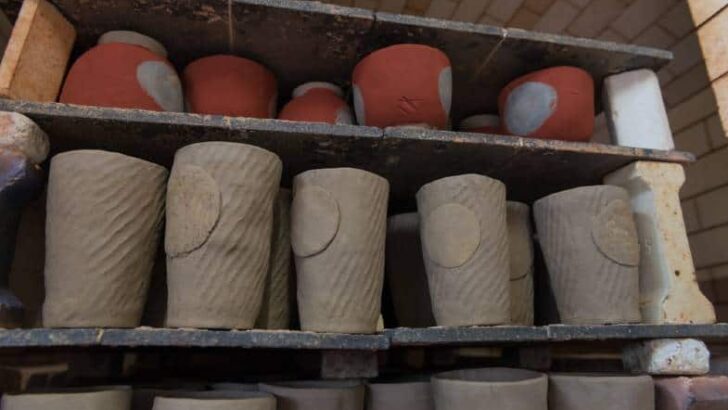
Affiliate Disclaimer
As an affiliate, we may earn a commission from qualifying purchases. We get commissions for purchases made through links on this website from Amazon and other third parties.
Usually, clay is fired two times. The first time is the bisque fire and the second time is the glaze fire. Clay undergoes changes during both of these firing processes. And this article is all about what happens to clay when it is fired in a bisque and a glaze fire.
In essence, when clay is fired it undergoes major physical and chemical changes. In the bisque fire, it changes from soluble clay to hard insoluble ceramic. And in the glaze fire, stoneware and porcelain clay transform from porous bisque ware to a dense watertight vitreous ceramic.
To find out more about what happens when these changes occur, read on. This article will cover:
- What happens to clay when it’s bisque fired
- What happens to clay when it’s glaze fired
- How these changes vary between different types of clay
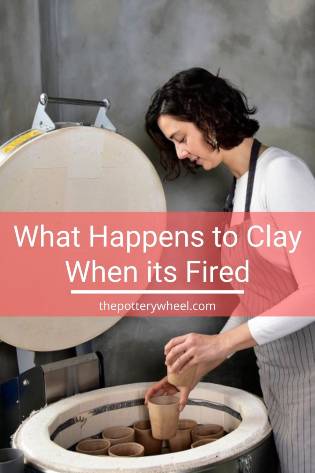
What Happens to Clay When it is Fired?
The first firing of clay is called the bisque or biscuit fire. During the bisque fire, clay is transformed from fragile greenware clay that will dissolve in water, to hard ceramic material.
‘Greenware’ is the name given to unfired pieces of pottery. And ‘bisque ware’ is used to refer to clay that has been bisque fired.
Before greenware clay is fired it needs to be dried out. Although dried greenware is solid it is not strong. It breaks easily and if you put it in water, it will dissolve, or ‘slake down’ in the water.
During firing greenware clay undergoes incredible physical and chemical changes that alter it forever. Unlike greenware, bisque ware is hard, brittle, and durable. Bisque ware is still porous so it is not as hard as it could be. Nevertheless, it is stronger than greenware and can survive the odd bump here and there without breaking.
Because bisque ware is porous, it will absorb water readily. However, because of the changes the clay has undergone during firing, it is no longer soluble. Bisque ware does not dissolve in water.
So, what are these chemical and physical changes that happen to clay when it’s fired? How does greenware transform into bisque ware? Read on to find out…
Changes that Happen to Clay During the Bisque Fire
This is a description of what happens to clay when it is fired, as the temperature in the kiln rises. Some of the changes that are happening in the clay happen at the same time. Other changes overlap. Nevertheless, this is the basic order in which they occur at different temperatures during the firing process.
Change 1 – Drying out Residual Moisture
As mentioned above, before the clay is bisque fired, it’s important that it is dried out thoroughly. Clay going into the kiln needs to be bone dry, which means that it’s as dry as it can be.
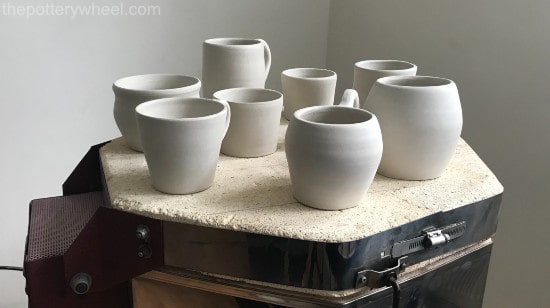
If clay goes into the kiln damp, it can break or explode when it is being fired. When moisture in the clay reaches the temperature of boiling water at 212F (100C) it turns to steam. As water turns to steam it expands quickly and massively. Steam is 1600 times the size of the water that produced it (source).
Because the steam is expanding it tries to find gaps in the clay that it can expand into. The steam migrates into air pockets and bubbles in the clay. But because it is expanding it puts a lot of internal pressure on the pottery. And the pottery is likely to break under the pressure.
If you think about it, steam engines rely on the huge pressure that water turning to steam produces. So, it’s not surprising that a piece of pottery will fail under this pressure. As a result, potters will wait until the piece feels bone-dry before loading it in the kiln.
However, even clay that feels bone dry will have some residual moisture nestled at deeper layers. And this needs to be evaporated, or ‘driven out’ in the first part of the firing schedule.
Mechanical Water
The residual moisture that is left in the clay after air drying is also called ‘mechanical water’ or ‘free water’. This water sits between the clay particles. It is not part of the chemical make-up of the clay. Rather it acts as a lubricant and an adhesive between the clay particles.
Usually, the very first part of the bisque firing is designed to get rid of this remaining moisture. The kiln is set to reach a temperature just below the boiling point of water. And it is held at that temperature for some time. During this ‘hold period’, where the kiln’s temperature stays static, the moisture evaporates out of the clay readily. That is why it’s called ‘free water’.
The length of time the kiln is left to hold at this temperature depends on a few things. For example, clay takes longer to dry if:
- Greenware is noticeably damp
- Pieces of pottery have thick or uneven walls
- The kiln is tightly packed
- The atmosphere in the studio is humid
Holding the kiln just below 212F (100C) is also called ‘candling’ or pre-heating. Some potters will candle overnight to be sure the clay is dry. However, often the kiln will be set to pre-heat for 2 or 3 hours.
This process will evaporate most of the atmospheric water in the clay. And by the time the kiln has reached 392F (200C), all of the mechanical water will have been driven out.
Once the clay is dry, and the pre-heat ends, the main firing schedule starts. So, let’s take a look at what happens to clay when it is fired once it’s completely dry.
Change 2 – Organic Carbons Burn Out
All pottery clay contains organic matter of one kind or another. Carbons are non-metallic elements, and organic matter is material that is made up of the remains of naturally occurring organisms. Put simply, organic matter in the clay can consist of debris such as particles of leaves, wood, and vegetation. Pottery clay is, after all, processed mud.
Different types of clay contain different quantities of organic matter. Some are classified as low organic, and others are high organic.
It’s important that these organic compounds are burned out during the bisque fire. This is because when they burn they produce gases. The gases need to leave the clay during the bisque fire rather than the glaze fire. If carbon-related gases try to leave the clay during the glaze fire, it can cause defects in the glaze.
There are different accounts of when organic burn out occurs in the bisque fire. Some sources state that it occurs between 300-600F (149-316C). And other accounts state that it occurs between 572-1292F (300-700C).
What I have noticed, is that my kiln gives off a smoky burning smell up between 300 – 570F (150- 300C). And my instinct is that this is when the bulk of the organic carbon burn out is happening.
Paper and coal are organic carbons. And if you were to burn these they would produce smoke and gases. The same is true of organic carbons being burned out of clay.
Ventilation
During this part of the firing schedule, it’s important that there is airflow in the kiln. This is for two reasons. Firstly, the fumes created by the burn out need to be able to exit the kiln.
Secondly, the carbons will only burn out of the clay fully if they have enough oxygen to burn. For that reason, potters usually leave the spy holes or peepholes on the kiln open during this period.
It’s important that the organic carbons have the chance to burn out. And this takes time, particularly for clays that have a high carbon content. This is one of the reasons why potters tend to fire slowly during the first part of the bisque fire. If the temperature increases relatively slowly, the carbons have more chance to burn out.
Change 3 – Dehydration
Although the residual moisture has evaporated during the pre-heat, there is still some water left in the clay. The water that is left after the boiling point of water has passed is called ‘chemical water’. This is water that is chemically bound to the clay particles.
Unlike the mechanical water that sits between the clay particles, ‘chemical water’ is actually part of the particle’s chemical make-up. During the firing schedule, the chemical bond between the clay and the water needs to be broken. And the water molecules need to be driven out of the clay.
This process is known as ‘dehydration’ or it is sometimes called ‘dehydroxylation’. The dehydration process begins at around 896F (480C) and is complete by around 111F (600C) (source).
Once all the chemical water has been driven out, the clay has been stripped of its water content. At this point, it is completely dehydrated and it has undergone an irreversible change.
When the clay is completely dehydrated, it has been turned from clay to ceramic material. The pottery has now been changed from fragile soluble greenware to insoluble hard bisque ware.
Change 4 – The Quartz Inversion
At the point just before dehydration is complete the clay goes through a change called the quartz inversion. This happens at about 1063F (573C).
Quartz is a crystalline mineral. Being crystalline means that it has a crystal structure. And minerals are inorganic solid matter. So, quartz is an inorganic crystal that occurs in clay bodies. Quartz is also a source of silica in the clay.
As the temperature in the kiln increases the crystals that make up the quartz rearrange themselves. And as this occurs the quartz expands quickly by 1-2%.
It is called a quartz inversion because the quartz contracts by the same amount as the clay cools down. The expansion occurs at about 1063F (573C) on the way up. And the contraction happens at the same temperature on the way down.
The quartz inversion can cause cracking in a piece of pottery. However, it’s more likely to cause cracks when the kiln cools after glaze firing stoneware or porcelain. This is because once clay has been fired at stoneware temperatures it is denser and more solid, and has less give in it. By contrast, porous bisque is more able to adapt to the expanding quartz.
Nevertheless, it’s a good idea to pass slowly through the quartz inversion temperature on the bisque fire too. This is because the quartz inversion happens at the same time that chemical water is being driven out of bisqueware. The loss of moisture causes the clay to shrink. So, the quartz is expanding at the same time that the clay is shrinking. This can put pressure on the clay and cause cracking.
Change 5 – Inorganic Carbons Burn Out of the Clay
Between 1292-1652F (700-900C) more carbons are burned out of the clay. These carbons, unlike the earlier burn out are inorganic rather than organic.
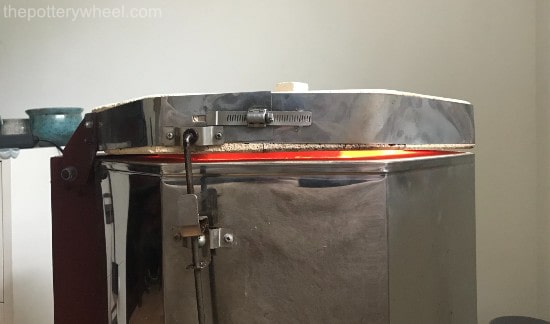
Organic carbons are the natural product of plants and living things. By contrast, inorganic carbons have been extracted from ores minerals like iron and coal (source). Most inorganic compounds do not contain carbon. But a small number do, and one of these is sulfur. (source)
In clay, inorganic sulfides that come from coal particles and iron need to be burned out of the clay. If these sulfides are not burned out during the bisque fire, they can cause problems like bloating and blistering later.
The burning out of inorganic carbons produces gases that need to be ventilated. For example, burning sulfur compounds create gas which when mixed with water creates sulfuric acid.
If this gas is inhaled or comes into contact with the eyes or saliva, it combines with bodily moisture. This creates a small but irritating amount of acid. The burning of sulfur during firing can also account for some of the smells that might come from your kiln.
Most inorganic compounds in the clay will have been burned out by 1652F. And sulfur will have been burned out by 2102F (1150C) (source).
Change 6 – Sintering
Water in clay adds to the volume of the clay. It also acts as a lubricant and bonds the clay particles together. When the water content of clay is driven out during firing, the clay body loses a bonding agent. The clay particles are no longer being held together by water.
However, the point in the firing schedule where clay has lost its water content is when another bonding process begins. This process is called ‘sintering’. As clay heats up, particularly at the point when it is red hot, the clay particles move closer together.
They move closer together for a few reasons. Firstly, as the clay heats up, the matrix of particles is less rigid and they can move about more freely. Secondly, the particles have lost some volume and are smaller. This means they can pack together more tightly.
Not only do the clay platelets move closer together, but the particle surfaces that are touching begin to bond together. This bonding occurs because molecules from the clay particles begin to move between neighboring particles. The platelets begin to intermingle.
During the sintering process, the clay becomes more compact and denser. As a result, it is also called densification.
Change 7 – Decomposition
A further change that happens to clay when it is fired, is that some of its ingredients will decompose. So far, we’ve covered evaporation, dehydration, burnout, and sintering. Decomposition is different in that it involves some of the materials in the clay being broken down into smaller pieces.
For example, minerals are compounds, which means that they are made up of more than one element. During the firing process, the bond between these elements is broken and the mineral breaks down into its smaller parts.
When the bond is broken, the minerals will often give off gases that need to be vented. Some clay, like porcelain, is cleaner clay and doesn’t contain as many minerals. Other clay bodies do contain a higher quantity of minerals and undergo a greater amount of decomposition.
For example, terracotta is in impure clay, that contains lots of minerals and iron oxide. When terracotta is fired, a lot of decomposition takes place, as its high mineral content breaks down and expels gases.
Another important change that occurs through decomposition is that mullite crystals are formed in the clay. Mullite is long ‘needle-like’ crystals made of aluminum silicate. These are formed when feldspar melts around kaolinite crystals in the clay (source)
The transformation of kaolin into mullite starts to happen around 1922-2012F (1050-1100C). Clay is often bisque fired up to 1823F (995C), which is referred to as cone 06. Some potters will bisque fire to a higher temperature of 1949F (1060C). Depending on the bisque fire target temperature, mullite crystals may or may not have begun to form in the ceramic. So, this process may have begun in some bisque fired pottery.
What Happens to Clay When it is Fired at Higher Temperatures?
Forming mullite crystals involves the melting of materials, and it is part of the beginning of the vitrification process. Vitrification occurs when materials in the clay begin to melt and form glass in the clay. This process happens at temperatures that are higher than bisque firing temperatures. Let’s take a look at those processes now….
So, What’s Next?
Most of the changes outlined above happen, for the most part, during the bisque fire. However, bisque firing is not the end of the road for pottery. And a fuller account of what happens to clay when it is fired should include an overview of glaze firing too.
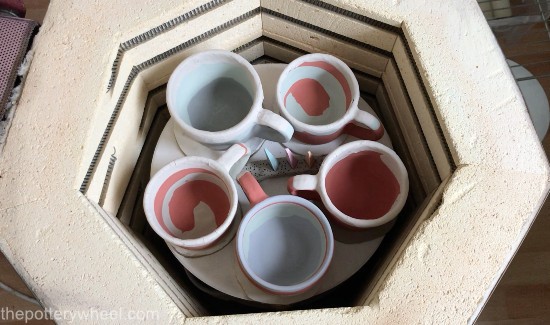
Different types of clay undergo different changes in the glaze fire. For example, earthenware clay is a low fire clay. That means that it can only tolerate being fired at lower temperatures.
Earthenware Clay
Generally, earthenware clay prefers to be fired up to bisque temperatures and no higher. If it is fired beyond bisque temperatures, earthenware clay can start to become brittle. This is because it has been over fired.
Usually, when earthenware clay is glazed, the glaze firing temperature is the same as a bisque firing temperature. In fact, it’s quite common practice for pottery to be glazed at a slightly lower temperature than the bisque fire.
For example, the bisque fire might be at cone 04, which is around 1940F (1060C). Whereas, the glaze fire might be at cone 06, which is around 1823F (995C).
The reason for firing at these temperatures is that it can help you avoid glaze defects. When gases continue to escape from the clay during the glaze fire, they can cause blisters, pinholes, and cloudy glaze.
If you glaze fire at a lower temperature than you bisque fired, further gases are not emitted by the clay. This is because any burnout that is due to happen at the bisque temperature or lower will have happened already.
As such, earthenware clay has undergone most, if not all of the changes it goes through during the bisque fire.
Stoneware Clay and Porcelain
Stoneware clay is a mid or high fire clay. And porcelain clay is generally a high fire clay. Both of these clay bodies need higher temperatures than earthenware to be fired to completion. Mid-fire stoneware temperatures start at 2158F (1180C) and, go all the way up to high-fire temperatures at 2377F (1300C).
As such, when glazing stoneware and porcelain the glaze firing temperatures are higher than bisque temperatures. Both stoneware and porcelain clay continue to undergo changes in the higher temperatures of the glaze fire. So, let’s take a look at what happens to clay when it is fired to higher temperatures….
Change 8 – Vitrification / Maturation
During the glaze fire stoneware and clay become stronger, denser and less porous. This process is called maturation. A clay is said to be mature, when it is as strong and dense as it can be.
When clay is fired at temperatures that are too high for it to cope with, it is referred to as being overfired. Overfired clay can be very dense, but it will also be brittle. Mature clay on the other hand is dense but strong.
Densification is a process that starts during the bisque fire, when the clay particles start move closer together, and bond. However, it continues throughout the firing process and reaches a peak during the glaze fire.
At higher temperatures in the glaze fire, new crystals begin to form in the clay. Mullite is one of the crystals that begins to form. These new crystals form a structure in the clay that is like an internal scaffolding.
In addition to this, the clay goes through a process of glassification. This means that the glass-forming ingredients in the clay melt, forming liquid glass. The liquid glass fills up spaces between clay particles and crystals, and makes the clay less porous. Also, once the glass has cooled and solidified, it adds strength to the ceramic ware.
When the pores in the clay are filled with glass, the clay is said to be vitreous. Depending on how much glass is produced the clay may be semi or fully vitreous.
Degrees of Vitrification
Just how vitreous the clay is once fired, depends on a few factors. Firstly, it depends on how many glass-forming materials there are in the clay. A clay body with few glass-forming materials, will not reach a high degree of vitrification.
The other factor that affects vitrification is the temperature that is reached during firing. A clay body might be capable of becoming vitreous, but if it isn’t fired hot enough, it won’t fully mature.
Vitrification is a process, and to be completed it requires increasing amounts of heat. Two of the key ingredients in clay are fluxes and silica. Silica is a glass-forming ingredient, and it has a high melting point of around 3092F (1700C). This is a much higher temperature than any pottery reach.
Fluxes like ‘feldspar’ lower the temperature at which silica melts. As feldspar heats up in the kiln, it seeks out silica from the other materials in the clay. For example, it will draw silica out of quartz and kaolin in the clay.
As the silica is drawn into the molten flux, silicates are formed. Silicates are minerals with a crystal structure (source). These crystals need more heat to melt. So, the temperature in the kiln needs to rise further for the mix to become fluid. As it does, the flux continues to seek out and convert more silica.
So, during vitrification, some ingredients in the clay are decomposing. For example, silica is being drawn from quartz and kaolin. Crystals like mullite are being formed. And liquid glass made up of flux and melted silica is forming a fluid around these structures.
Final Thoughts
This has been an overview of what happens to clay when it is fired. As you can see, there is a lot going on. Given the number of changes it undergoes, I’m always amazed when I open the kiln and my pottery has survived. The wonders of modern electric kilns with digital controllers have made firing pretty simple. Provided your pottery is bone dry generally, you are safe to put it in the kiln and press ‘go’. But this simplicity disguises the complex change that happens to clay when it’s fired.
If you enjoyed this post, please share it!



